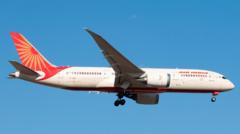What’s Unfolding in the Air India Crash Investigation?

Understanding the Investigation Process of Air India Flight 171: Key Aspects and Insights
The tragic crash of Air India Flight 171 just moments after takeoff has left the aviation world in shock. In a matter of seconds, a routine flight transformed into a devastating incident, prompting urgent investigations into the causes of the crash. As investigators sift through the wreckage and analyze flight data, it becomes crucial to understand how these processes unfold and what they entail. This article will delve into the complexities of aviation investigations, the various factors at play, and what the future may hold as we seek answers.
The Scene of the Incident
On that fateful day, Air India Flight 171 departed from Ahmedabad, India, with 242 passengers and nearly 100 tonnes of fuel on board. Within less than 40 seconds, the aircraft—an advanced Boeing 787 Dreamliner—plunged into a densely populated area, resulting in catastrophic consequences. The initial investigation focuses on the critical moments following takeoff, which raises numerous questions about potential mechanical failures, human errors, and environmental factors.
The Role of Investigators
Investigation into aviation accidents like Flight 171 is a meticulous and systematic process. Here's an overview of what investigators will focus on:
1. Recovery of Black Boxes
The Enhanced Airborne Flight Recorders (EAFRs), commonly known as “black boxes,” play a pivotal role in uncovering the details of what happened during the flight. These devices record:
- Flight data, including altitude, speed, and engine performance
- Cockpit audio, capturing pilot communications and ambient sounds
The recovery of these black boxes from the crash site is crucial for piecing together the events leading up to the disaster.
2. Aircraft Condition and Maintenance History
Investigators will examine the maintenance logs and service history of the aircraft. This includes:
- Documentation of past inspections and repairs
- Details of any reported faults and corrective actions taken
Such records are essential in determining whether there were underlying issues with the aircraft that could have contributed to the crash.
3. Engine Performance Analysis
The two engines of the Boeing 787 are crucial to the investigation. Investigators will look for:
- Damage patterns on the engines to assess if they were operational during the crash
- Signs of bird strikes, fuel contamination, or mechanical failures
Understanding the engine performance at the time of impact can provide significant insights into what went wrong.
4. Environmental Factors
Conditions at the time of takeoff, such as temperature, wind speed, and potential wildlife hazards, will also be scrutinized. High temperatures can affect aircraft performance, especially during takeoff. Investigators will examine:
- The impact of extreme heat on the aircraft's lift
- The presence of birds in the vicinity
A comprehensive understanding of environmental conditions will be critical in determining contributing factors.
5. Crew Actions and Training
The actions taken by the flight crew just before the crash will also be a focal point. Investigators will review:
- Pilot training records and qualifications
- Simulator performance and handling of emergency scenarios
Understanding how the crew responded to the situation in the cockpit could reveal whether human error played a role in the incident.
Technological Advances in Aviation Investigations
The evolution of technology has transformed how aviation accidents are investigated. Modern flight data recorders can capture hundreds of parameters every second, providing a wealth of information that was previously unavailable. This advancement allows investigators to analyze a broader range of data to pinpoint issues more effectively.
Potential Causes of the Crash
As investigators delve deeper, several potential causes are emerging, each requiring thorough examination:
1. Engine Failure
One of the most critical questions is whether both engines failed simultaneously. If so, potential causes could include:
- Mechanical failure due to maintenance errors
- Fuel contamination
- Bird strikes or other external factors
2. Pilot Error
Human error can also be a significant factor in aviation accidents. Investigators will look at whether:
- The crew followed proper protocols during takeoff
- There was any miscommunication between the captain and co-pilot
3. Aircraft Design Issues
If data from the flight recorders points to a systemic problem with the aircraft's performance, it could raise concerns not just for Air India but for the wider aviation industry. Possible areas of investigation include:
- Flap and slat configurations
- Flight management control systems
The Importance of Thorough Investigations
Investigations into aviation accidents are complex and time-consuming. They require collaboration among various stakeholders, including:
- Aircraft manufacturers
- Airlines
- National and international regulatory bodies
While preliminary reports can provide early insights, comprehensive investigations may take months or even years to conclude. This thoroughness ensures that lessons are learned and safety measures are improved to prevent future tragedies.
Conclusion: The Road Ahead
The investigation into Air India Flight 171 is just beginning, and while answers may take time, the aviation community remains vigilant in its commitment to safety. Every piece of evidence gathered will contribute to a clearer understanding of the crash and help implement necessary changes in aviation protocols and technologies.
As we await further developments, it is essential to reflect on the inherent risks of aviation and the rigorous safety measures that have evolved over decades. Aviation will continue to adapt and improve, driven by the pursuit of safety and the lessons learned from past incidents.
FAQs
What are the typical steps taken in an aviation accident investigation?
Aviation accident investigations generally follow a sequence of steps, including the recovery of flight recorders, analysis of wreckage, examination of maintenance records, and interviews with crew members and witnesses.
How long does it usually take to complete an aviation investigation?
Preliminary reports are often released within 30 days, while comprehensive investigations can take up to 12 months or longer, depending on the complexity of the case.
What role do black boxes play in investigations?
Black boxes record critical flight data and cockpit audio, providing essential information about the aircraft's performance and crew communications leading up to an accident.
In the wake of tragic incidents like Air India Flight 171, we are reminded of the importance of vigilance in the aviation industry. How will this incident influence future aviation safety protocols? #AviationSafety #AirIndia #FlightInvestigation
Published: 2025-06-18 00:14:02 | Category: world



